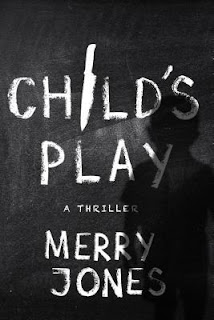Don’t get it
wrong: Child's Play is not a children’s book. Nor is it a book about games and
toys, or the importance of either.
No, Child's Play is a dark and shadowy thriller that begins in an elementary school. And
however slightly, food plays a part in the story.
Since the
main character, Elle Harrison, is a second grade teacher, the first and
foremost food item on the book’s menu is peanut butter sandwiches. Even though
in reality, some classrooms forbid peanut butter due to student allergies,
Logan Elementary is a fictional school. Peanut butter is the number one
favorite sandwich of the kids who go there.
They also
like ice cream. Ice cream man Duncan Girard parks his truck at the edge of the
school yard. Kids line up there every day, eager for treats.
Beyond ice cream and peanut butter, food plays
an important part in depicting the characters in the book. For example,
protagonist Elle. She is recently widowed, her house for sale. For her, food is
a reminder of meals shared with her husband. Cooking and eating have become
excruciatingly lonely. So she doesn’t cook, doesn’t even keep food in her
house. When her friends come over, one complains that she has only stale
crackers and a half empty jar of peanut butter in her pantry, only a hard block
of cheese, mustard and mayo in the refrigerator.
Even if
there’s not much food in Elle’s house, she has an abundant supply of wine.
Pinot, Cabernet and, her favorite, Shiraz. Wine, she finds, eases her
loneliness and softens her moods.
Unlike Elle
who is indifferent to food, her friend Jen is continuously ravenous. She’s
someone who never stops eating and never gains an ounce. Food is always on her
mind, and usually in her mouth. If all she can find is a stale cracker and some
peanut butter, then that’s what she’ll eat. Jen is married to a man with
similar hunger, but his is aimed at accumulating wealth rather than calories.
Jen enjoys the fruits of his efforts, but possibly not as much as she enjoys
actual fruit.
Another of
Elle’s friends, Susan, is the opposite of Elle when it comes to food. She is a
cook, a nurturer, a mother. When Elle is upset about a colleague’s murder,
Susan offers to bake banana bread. What could be more comforting than warm
fresh-from-the-oven banana bread? When her friends get together, Susan always
whips up a meal from whatever odds and ends she has on hand—like a last minute
yummy frittata of eggs, onions, red pepper, tomato, mushrooms and cheeses. Even
when she and her friends end up eating at Elle’s, Susan is in charge of food. After
a traumatic day in the emergency room with Elle and Jen, Susan makes sure they
are well fed on Chinese: General Tso’s chicken, Moo Shoo pork, shrimp and
broccoli, and hot and sour soup.
In Child's Play, the relationships characters have with food reflect who they are and how
they live. One character uses coffee as a friend, a crutch, an energy boost.
Elle uses wine much the same way. Food shared makes a community, enhances the
bonds of friendship. Food taken in solitude can reveal an insatiable neediness
in Jen’s character, a reminder of loneliness in Elle’s.
Having said
that, sometimes it’s not the characters relationships to food, but the food
itself that offers meaning. For example, when against all advice, Elle goes to
a deli with a convicted killer who’s suspected of serial murders, readers are
clued in that he might not be such a bad guy. Why? Because he orders an ice
cream soda.
I suppose,
in reality, serial killers might drink ice cream sodas. But in my book, ice
cream sodas are synonymous with honesty, decency and kindness. They scream
innocence.
Thanks for stopping by to share your food for thought, Merry!
You can find Merry here:


No comments:
Post a Comment